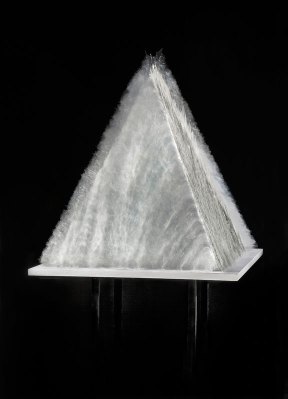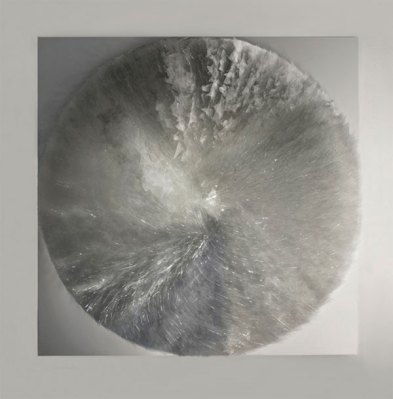 Josepha Gasch-Muche, Pyramid, 2010. Glass, wood and aluminum base. H 33 1/2, W 31 1/2, D 31 1/2 in. courtesy: Heller Gallery
Josepha Gasch-Muche, Pyramid, 2010. Glass, wood and aluminum base. H 33 1/2, W 31 1/2, D 31 1/2 in. courtesy: Heller Gallery
Despite being made from thousands of dangerous-looking glass shards, Josepha Gasch-Muche‘s ethereal geometric works in “Mutable Materiality,” on view at Heller Gallery from Oct. 14 to Nov. 12, are glowing and inviting. With thousands of glass shards at her disposal, she creates wall panels and three-dimensional forms that channel her greatest obsession: light.
“From the beginning, the most important and lasting inspiration for my work has been light. Light appears, briefly flashes, and disappears. It cannot be captured, but in several of my works I succeeded in taming it. This is a great and exciting challenge. I want to design using light. Light has a positive influence on our mind, affects us in a very essential, original way,” she told the Hot Sheet in an interview in February. “My objects present the diverse and unlimited variations of the manifestations of light using the medium of glass.”
All of the pieces in “Mutable Materiality” are comprised of blacks, whites and grays amplified by light reflecting through the layers of glass shards at unpredictable angles. Gasch-Muche’s fascination with light results in glass paintings whose atmospheric contours simultaneously evoke the moon’s surface and the ocean tides it helps create. To construct her works, she uses industrial liquid crystal display glass, typical of cell phone screens, as her primary medium. She takes pliers to glass as thin as 1/100th of an inch, breaking it into the thousands of tiny fragments that comprise the majority of her creations.
 Josepha Gasch-Muche, 17.2.2011, 2011. Glass, wood panel. H 49 1/4, W 49 1/4, D 7 7/8 in. courtesy: Heller Gallery
Josepha Gasch-Muche, 17.2.2011, 2011. Glass, wood panel. H 49 1/4, W 49 1/4, D 7 7/8 in. courtesy: Heller Gallery
Her work has drawn comparisons to Zero artists like Heinz Mack and Günter Uecker, but her use of light, color palette, and personal philosophy recall the Pictorialists’ approach toward photography in the early 20th century. Like many contemporary glass artists, the Pictorialists viewed themselves as craftsmen, incorporating painting, drawing and etching techniques into their photographs. In Gasch-Muche’s Pyramid, a vibrant pyramid sits in a light fog of glass shards, a glass version of the soft focus employed by photographers like Gertrude Käsebier and Edward Steichen for the same painterly effect. The meticulously-arranged shards in elegant circular wall panels like 17.2.2011, 7.3.2011 and 7.4.2011 form glass versions of the swirling, cirrus cloud formations that so captivated photographer Alfred Stieglitz in his Equivalents series. 7.1.2011, an arrangement of four squares that appears heavily etched, recalls the pins and needles photographers such as Frank Eugene took to their negatives.
“The wall objects are painting with light; there is an utter lack of pigments,” she told the Hot Sheet. “The carriers are always white or black. Light does the painting. Opposing, layered pieces of glass create the composition on the carrier. As a colorless and transparent material, glass requires light for this special type of painting.”
—Grace Duggan
IF YOU GO: Josepha Gasch-Muche“Mutable Materiality”
October 14, 2011 – November 12, 2011
Opening reception: Thursday, October 13th, 6-9PM
Heller Gallery
420 West 14th Street
New York, NY 10014
Tel: 212.414.4014
Website: www.hellergallery.com


